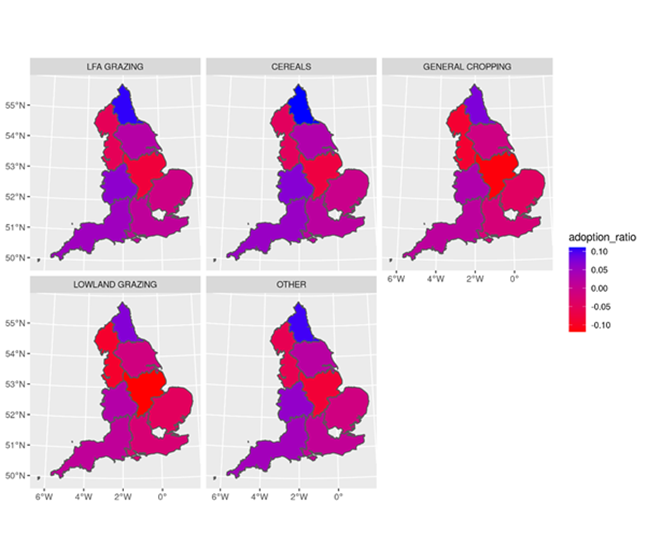Farmer schemes to improve and maintain the environment
Uptake of schemes encouraging farmers to help improve and maintain the environment varies across England, the main factors influencing uptake are having previous experience and how many hectares are farmed.
Project overview
Most investigations into policy adoption by farmers rely on questionnaires and surveys, however there is inherent bias in self-reported survey results. Such investigations are also frequently limited to small sample sizes. Patterns of adoption are known to vary considerably with differences within and between countries. This project aimed to explore the influence of farmer-to-farmer social interactions on policy adoption, as well as geophysical, environmental and social variables, using data based on the entire farming population of England.
Data and methods
This project aimed to develop an understanding future uptake of novel agri-environment schemes (AES) being introduced to England, to replace those funded by the EU. Using securely held, anonymised data within the Department for Environment, Food and Rural Affairs (Defra), based on the June Agricultural Survey from 2019, a predictive logit model was built. Additional variables such as average field size, number of farming neighbours and geospatial and environmental data were included to predict uptake of AES.

Key findings
This study confirmed earlier findings that farm size and farm type affect adoption rates of AES. We also found that having land within an area of outstanding natural beauty and Site of Special Scientific Interest significantly increase adoption rates. Aside from factors previously known to influence adoption, this study showed that the prior experience of schemes and a farmer’s neighbour’s experience also have direct effects.

Value of the research
This research offers key insights in to what factors are likely to influence the uptake of AES, helping to predict the costs of new AES. Additionally the understanding of which factors are likely to increase uptake of AES can be used by policy makers to incentivise farmers to continue to care for, and improve, the natural environment whilst ensuring food and produce supply for England.
Quote from project partner
“This work will help us to both understand and model uptake of Agri-Environment Schemes, expanding on an area where we had little to no knowledge. Social or spatially driven spread of uptake may be a crucial component in ensuring high participation and delivering the best environmental outcomes”
James Foley, Head of Data Science and Modelling Team - Environmental Land Management, Department for Environment, Food and Rural Affairs
Insights
The most important variable in influencing uptake of AES is in fact having been involved with an agri-environment scheme previously. Other important factors that influence uptake of AES include the area of the farm, with larger farms having greater uptake, and having fields that are within Sites of Special Scientific Interest (SSSI). Having neighbours within 2.5km which have had an AES grant in the past does have a small positive influence on the uptake of AES, depending on the region in which the farm is based.
Research theme
Urban analytics
People
Dr Jiaqi Ge, University of Leeds
Prof Guy Ziv, University of Leeds
Dr James Foley, Defra
Katie Killick, Defra
Environmental Land Management Team, Defra
Partners
Department for Environment, Food and Rural Affairs
Funders
BESTMAP Grant Agreement Number 817501 https://bestmap.eu/
